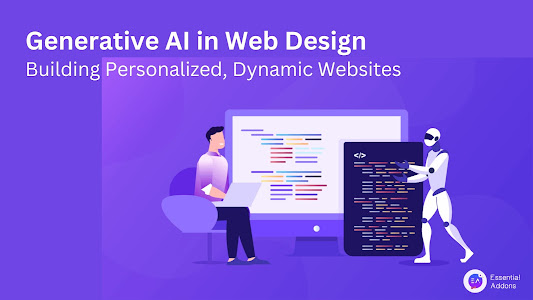As technology continues to evolve, generative AI is transforming the world of web design. This innovative technology is enabling designers and developers to create websites that are not only visually striking but also highly personalized and dynamic. Generative AI uses algorithms to generate unique designs and layouts that can adapt to user needs and preferences. By automating the design process, generative AI allows web designers to focus on creating a more engaging and seamless user experience.
In this article, we'll explore how generative AI is changing the landscape of web design, the benefits it offers, and how businesses can use this technology to create personalized, dynamic websites that drive user engagement and business growth.
What is Generative AI?
Generative AI refers to a branch of artificial intelligence that uses algorithms to generate new content, whether that be images, text, or designs. Unlike traditional AI, which relies on predefined rules and templates, generative AI learns patterns from large datasets and applies that knowledge to generate new outputs. In web design, generative AI can create layouts, design elements, and even entire websites based on user preferences, past behavior, and business goals.
Generative AI algorithms are capable of analyzing user data to create personalized website experiences. By understanding user behavior, preferences, and interactions, generative AI can build websites that dynamically change and adapt to the needs of individual users. This allows for more intuitive and engaging experiences that can boost conversions and customer satisfaction.
For businesses looking to create innovative, user-centric websites, working with a Wordpress website design company like SFWPExperts can provide the expertise and technology needed to succeed. With the power of generative AI, the future of web design is brighter than ever.
The Role of Generative AI in Web Design
Generative AI has the potential to revolutionize how websites are created and managed. Traditional web design processes are often time-consuming and resource-intensive, requiring manual input from designers and developers. With generative AI, many of these tasks can be automated, speeding up the design process and enabling designers to focus on higher-level decision-making.
Here are some of the key roles that generative AI plays in modern web design:
- Automated Design Generation
Generative AI can create entire website layouts, designs, and user interfaces automatically. By inputting specific parameters such as brand guidelines, color schemes, and user behavior data, the AI can generate unique, visually appealing designs that align with business goals. This not only saves time but also ensures that the design is tailored to the specific needs of the user.
2. Personalization at Scale
One of the most significant advantages of generative AI in web design is its ability to offer personalized experiences at scale. AI can analyze user data such as browsing history, preferences, and location to deliver personalized content and design elements. For example, an eCommerce website powered by generative AI might show different layouts, product recommendations, and promotional banners based on the user’s past interactions with the site.
3. Dynamic Content Generation
Generative AI enables the creation of dynamic websites where content and design elements adapt in real-time based on user interactions. This can include personalized landing pages, dynamically generated forms, and real-time recommendations for products and services. By making the website more interactive and responsive to user needs, businesses can significantly enhance user engagement and retention.
4. AI-Assisted Design Tools
Generative AI tools such as automated design software, template generators, and AI-powered wireframe tools are helping web designers speed up the process of building websites. These tools allow designers to quickly iterate on designs, test multiple layouts, and receive AI-generated suggestions for improving the user experience. As a result, the overall design process becomes more efficient, with fewer manual revisions needed.
5. User Experience Optimization
Generative AI helps web designers create websites that are optimized for user experience (UX) by analyzing data on how users interact with the site. This data-driven approach allows designers to make informed decisions on layout, content placement, and call-to-action buttons, resulting in websites that are more intuitive and user-friendly. By constantly learning and adapting, generative AI ensures that the website evolves to meet the changing needs of its users.
Benefits of Generative AI in Web Design
Generative AI offers numerous benefits that can enhance the overall design process, improve user engagement, and help businesses stay competitive in the digital space. Here are some of the key benefits:
- Efficiency and Speed
Generative AI significantly reduces the time and effort required to design and develop a website. What once took weeks or even months to create can now be done in a matter of days, thanks to AI-powered design tools. By automating repetitive tasks such as layout generation and content placement, designers can focus on more strategic aspects of the design, ultimately speeding up the entire process.
Read More: Generative AI in Web Design: Building Personalized, Dynamic Websites
Read More Articles:
- Gutenberg WordPress Guide: How You Can Use WordPress Block Editor (Gutenberg)
- Inbound Marketing Series: What is Social Media Marketing (SMM)? 5 Core Pillars of Social Media Marketing
- 3 Ways to Boost Digital Marketing with Google Trends
- The Benefits of Responsive Design In WordPress Websites
- Step-by-Step Guide To Designing An SEO-Friendly WordPress Site
- WordPress Website Design: Common Mistakes to Avoid





